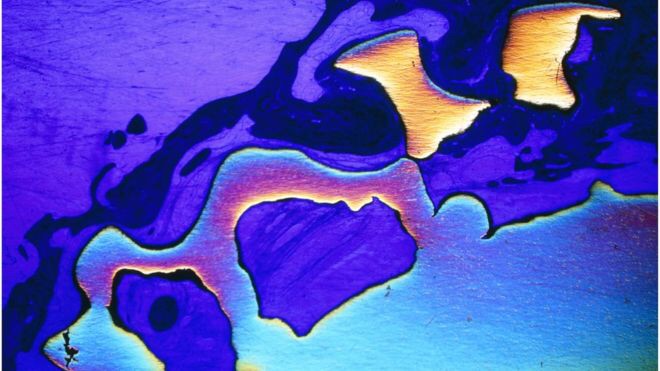
Cross-section of a titanium dental implant
โลหะผสมที่มีความแข็งอย่างมากถูกค้นพบ/ผลิตขึ้นในห้องปฏิบัติการ
ด้วยการจัดเรียงอะตอมระหว่างไทเทเนียมกับทองคำภายใต้อุณหภูมิสูง
โลหะผสมมักจะมีอาการ/ผลข้างเคียงกับเนื้อเยื่อของสิ่งมีชีวิต นักฟิสิกส์สหรัฐกล่าว
โลหะผสมดังกล่าวนี้มีความแข็งเป็น 4 เท่าของ Titanium บริสุทธิ์และเหล็กกล้าผสมชนิดอื่น ๆ
ทั้งยังมีอายุการใช้งานยาวนานขึ้นในด้านศัลยกรรมทางการแพทย์ เช่น หัวเข่าเทียม สะโพกเทียม
เพราะมีบางรายอาจจะต้องมีการเปลี่ยนใหม่ถ้าใช้นานเกินกว่า 10 ปี
ซึ่งส่วนมากมักจะใช้ Titanium ในร่างกายมนุษย์
เพราะความแข็งแรงและคนเราไม่ค่อยมีอาการแพ้โลหะชนิดนี้
รายละเอียดวัสดุใหม่นี้มีในวารสาร Science Advances
http://goo.gl/fKnMjE
Prof Emilia Morosan ที่ Rice University ใน Houston
ให้สัมภาษณ์ว่าทีมงานของเธอค้นพบโลหะผสมชนิดนี้
ระหว่างทำงานทดสอบกับ Unconventional Magnets
โลหะผสมดังกล่าวทำขึ้นจากผงที่ทดสอบความบริสุทธิ์
ด้วยการจัดเรียงอะตอมระหว่างไทเทเนียมกับทองคำภายใต้อุณหภูมิสูง
แต่ beta-Ti3Au เท่าที่ทราบกัน จะสามารถนำไปใช้ในงานภาคสนามได้
เพื่อทดแทนหัวขุด/หัวเจาะที่ทำด้วยเพชร หรือเคลือบด้วยผงเพชรละเอียดที่ขึ้นรูปเป็นเซรามิค
ที่ใช้งานในภาคสนามในการขุดเจาะบ่อน้ำ บ่อน้ำมัน ชั้นหินต่าง ๆ ในทางธรณีวิทยา
Ti-Au [titanium-gold] มีความแข็งสูงมากที่สุด
เมื่อทำการตรวจสอบเทียบวัดทางวิศวกรรมกับโลหะผสมชนิดอื่น ๆ
ความแข็งของมันจะสามารถนำไปใช้งานทางด้านต่าง ๆ ได้
ทำให้โลหะผสมนี้ในอนาคตเหมาะสำหรับการใช้งานด้านการแพทย์และทันตกรรม
ทั้งยังพัฒนาไปใช้ในงานอุตสาหกรรมขุดเจาะ การกีฬา และงานด้านอื่น ๆ ได้อีกมากมาย
เรียบเรียง/ที่มา
http://goo.gl/j3l58B
http://goo.gl/RckQ7o
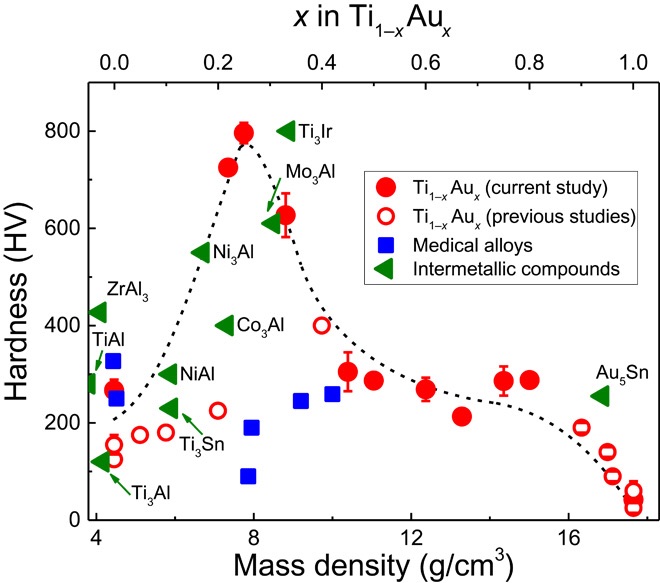
Fig. 1
Hardness of Ti1−xAux and other intermetallic alloys and compounds.
Hardness as a function of x (top axis) or mass density ρ (bottom axis) in Ti1−xAux.
Blue squares, medical alloys; green triangles, intermetallic compounds.
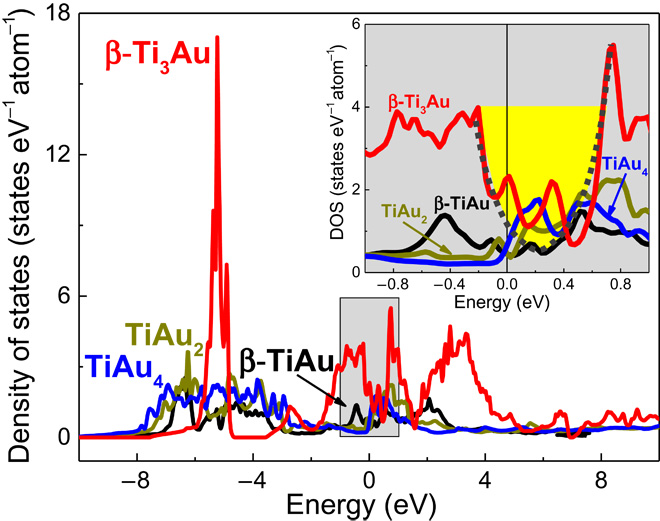
Fig. 2
Structural analysis of the Ti0.75Au0.25 alloy.
(A) Crystal structure of the α-Ti3Au phase along with the cuboctahedron local environments of the Au (left inset)
and Ti (right inset) atoms.
(B) Crystal structure of β-Ti3Au along with the icosahedron local environment of Au (left inset)
and the 14-vertex Frank-Kasper polyhedron local environment of Ti (right inset).
(C) XRD pattern was fitted with the β-Ti3Au phase (blue vertical symbols). Small inclusions of α-Ti3Au
and α-Ti are marked by asterisks. arb. units, arbitrary units.
(D and E) HRTEM (high-resolution transmission electron microscopy) images of the Ti0.75Au0.25 sample,
taken for the [111] and [100] orientations, respectively.
(F and G) SAD (selected area diffraction) images of the [111] and [102] orientations, resp
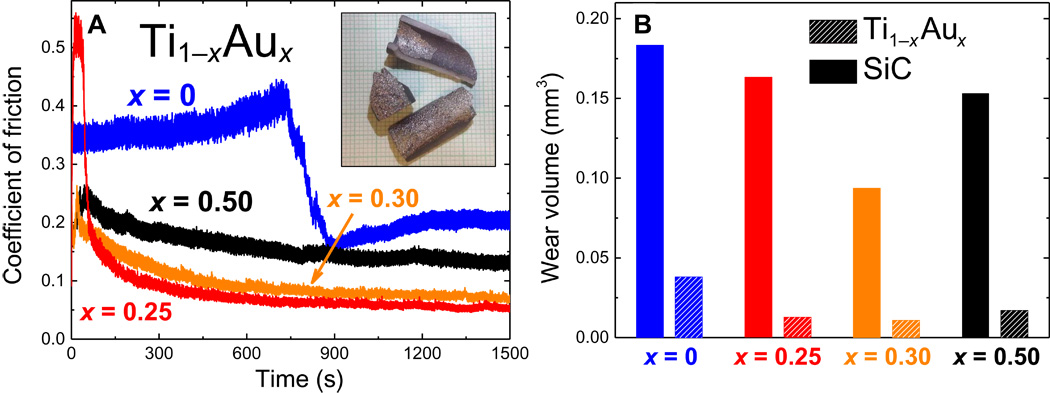
Fig. 3
DOS of Ti–Au stoichiometric compounds.
DOS (solid lines) as a function of energy for β-TiAu (black),
TiAu (yellow), TiAu4 (blue), and β-Ti3Au (red),
with the pronounced valley around the Fermi energy in β-Ti3Au
marked by a dotted line and highlighted in yellow (inset).
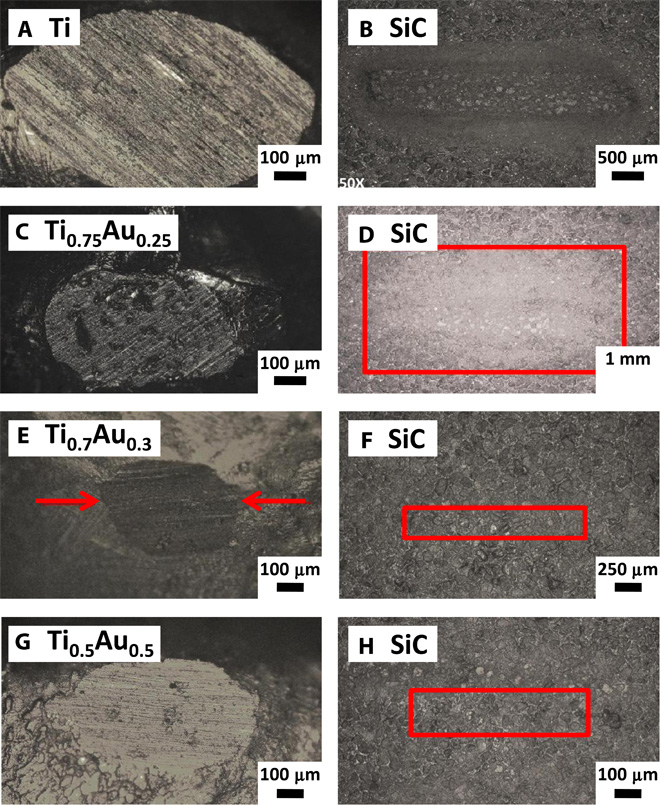
Fig. 4
Wear analysis of Ti1−xAux alloys against a diamond-SiC disc.
(A) COF as a function of time for x = 0, 0.25, 0.30, and 0.50. Inset:
An alumina container showing that Ti1−xAux adheres to this ceramic component.
(B) Wear volumes of Ti1−xAux (dashed) compared to diamond-SiC (solid).
β-Ti3Au โลหะผสมมีความแข็งเป็น 4 เท่าของ Titanium
Cross-section of a titanium dental implant
โลหะผสมที่มีความแข็งอย่างมากถูกค้นพบ/ผลิตขึ้นในห้องปฏิบัติการ
ด้วยการจัดเรียงอะตอมระหว่างไทเทเนียมกับทองคำภายใต้อุณหภูมิสูง
โลหะผสมมักจะมีอาการ/ผลข้างเคียงกับเนื้อเยื่อของสิ่งมีชีวิต นักฟิสิกส์สหรัฐกล่าว
โลหะผสมดังกล่าวนี้มีความแข็งเป็น 4 เท่าของ Titanium บริสุทธิ์และเหล็กกล้าผสมชนิดอื่น ๆ
ทั้งยังมีอายุการใช้งานยาวนานขึ้นในด้านศัลยกรรมทางการแพทย์ เช่น หัวเข่าเทียม สะโพกเทียม
เพราะมีบางรายอาจจะต้องมีการเปลี่ยนใหม่ถ้าใช้นานเกินกว่า 10 ปี
ซึ่งส่วนมากมักจะใช้ Titanium ในร่างกายมนุษย์
เพราะความแข็งแรงและคนเราไม่ค่อยมีอาการแพ้โลหะชนิดนี้
รายละเอียดวัสดุใหม่นี้มีในวารสาร Science Advances http://goo.gl/fKnMjE
Prof Emilia Morosan ที่ Rice University ใน Houston
ให้สัมภาษณ์ว่าทีมงานของเธอค้นพบโลหะผสมชนิดนี้
ระหว่างทำงานทดสอบกับ Unconventional Magnets
โลหะผสมดังกล่าวทำขึ้นจากผงที่ทดสอบความบริสุทธิ์
ด้วยการจัดเรียงอะตอมระหว่างไทเทเนียมกับทองคำภายใต้อุณหภูมิสูง
แต่ beta-Ti3Au เท่าที่ทราบกัน จะสามารถนำไปใช้ในงานภาคสนามได้
เพื่อทดแทนหัวขุด/หัวเจาะที่ทำด้วยเพชร หรือเคลือบด้วยผงเพชรละเอียดที่ขึ้นรูปเป็นเซรามิค
ที่ใช้งานในภาคสนามในการขุดเจาะบ่อน้ำ บ่อน้ำมัน ชั้นหินต่าง ๆ ในทางธรณีวิทยา
Ti-Au [titanium-gold] มีความแข็งสูงมากที่สุด
เมื่อทำการตรวจสอบเทียบวัดทางวิศวกรรมกับโลหะผสมชนิดอื่น ๆ
ความแข็งของมันจะสามารถนำไปใช้งานทางด้านต่าง ๆ ได้
ทำให้โลหะผสมนี้ในอนาคตเหมาะสำหรับการใช้งานด้านการแพทย์และทันตกรรม
ทั้งยังพัฒนาไปใช้ในงานอุตสาหกรรมขุดเจาะ การกีฬา และงานด้านอื่น ๆ ได้อีกมากมาย
เรียบเรียง/ที่มา
http://goo.gl/j3l58B
http://goo.gl/RckQ7o
Fig. 1
Hardness of Ti1−xAux and other intermetallic alloys and compounds.
Hardness as a function of x (top axis) or mass density ρ (bottom axis) in Ti1−xAux.
Blue squares, medical alloys; green triangles, intermetallic compounds.
Fig. 2
Structural analysis of the Ti0.75Au0.25 alloy.
(A) Crystal structure of the α-Ti3Au phase along with the cuboctahedron local environments of the Au (left inset)
and Ti (right inset) atoms.
(B) Crystal structure of β-Ti3Au along with the icosahedron local environment of Au (left inset)
and the 14-vertex Frank-Kasper polyhedron local environment of Ti (right inset).
(C) XRD pattern was fitted with the β-Ti3Au phase (blue vertical symbols). Small inclusions of α-Ti3Au
and α-Ti are marked by asterisks. arb. units, arbitrary units.
(D and E) HRTEM (high-resolution transmission electron microscopy) images of the Ti0.75Au0.25 sample,
taken for the [111] and [100] orientations, respectively.
(F and G) SAD (selected area diffraction) images of the [111] and [102] orientations, resp
Fig. 3
DOS of Ti–Au stoichiometric compounds.
DOS (solid lines) as a function of energy for β-TiAu (black),
TiAu (yellow), TiAu4 (blue), and β-Ti3Au (red),
with the pronounced valley around the Fermi energy in β-Ti3Au
marked by a dotted line and highlighted in yellow (inset).
Fig. 4
Wear analysis of Ti1−xAux alloys against a diamond-SiC disc.
(A) COF as a function of time for x = 0, 0.25, 0.30, and 0.50. Inset:
An alumina container showing that Ti1−xAux adheres to this ceramic component.
(B) Wear volumes of Ti1−xAux (dashed) compared to diamond-SiC (solid).